
Researching Historic Properties in Ohio County, West Virginia
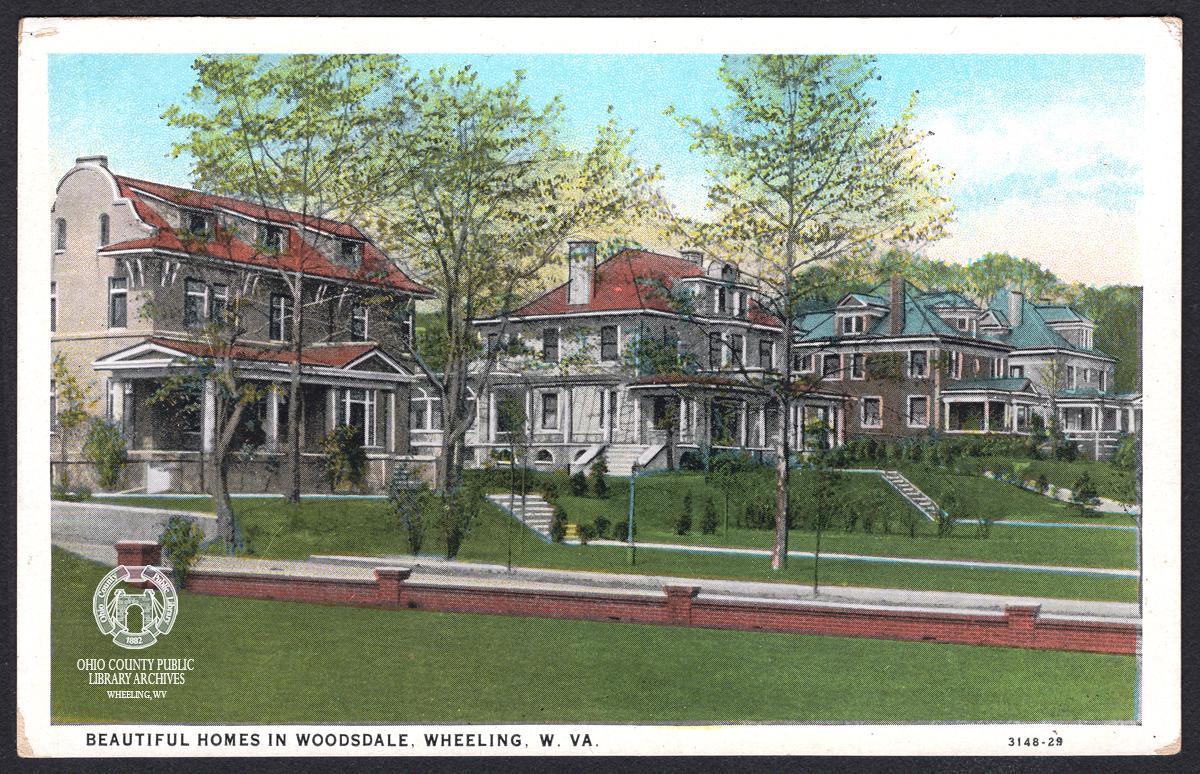 Tracing the history of a historic property can be daunting, but it can also be very rewarding. Many people want to know the history of their building out of general curiosity or interest in the past. Documenting a building's history, however, can be particularly helpful in making historically accurate renovations, or seeking financial incentives through tax-credits, obtaining technical aid and receiving matching grants from State Historic Preservation Offices, obtaining special exemptions from local or state building codes, and receiving grants from local preservation groups and historic district/City initiatives.
Tracing the history of a historic property can be daunting, but it can also be very rewarding. Many people want to know the history of their building out of general curiosity or interest in the past. Documenting a building's history, however, can be particularly helpful in making historically accurate renovations, or seeking financial incentives through tax-credits, obtaining technical aid and receiving matching grants from State Historic Preservation Offices, obtaining special exemptions from local or state building codes, and receiving grants from local preservation groups and historic district/City initiatives.
This pathfinder is designed to get you started documenting your property's history and getting familiar with resources available for historic restoration in Ohio County, West Virginia.
Getting Started
Research on historic buildings typically focuses on two areas — historic significance and integrity.
➤ Historic significance can be things like the distinctive design or physical details or the building, the architects who designed the building, people that lived in the building or the business that occupied the building, and any significant events or activities that happened in the building or on the property. Ways to begin researching your building's historic significance include (but are not are not limited to) looking at:
- Deeds: Creating a chain of deeds establishes historic ownership of a property and outlines how property boundaries have changed over time.
➤ View more information about deeds - City Directories: Using city directories, you can find the residents or businesses that have occupied a building over the years.
➤ View more information about city directories - Maps: Examining maps helps to establish location, verify construction dates, and see how a building's footprint changes over time.
➤ View more information about maps - Publications: Searching local newspapers or digitized architectural/construction trades publications can lead the uncovering significance information about your building such as the architects, contractors, original materials used, additions or remodels, significant events, visitors, uses, etc.
➤ View more information about accessing digitized publications
➤ Integrity is the survival of physical characteristics that existed during the property’s significant historic periods. This involves determining an architectural style and looking at the existing architectural materials and original elements still present in your building or determining which elements could be restored in the future.
➤ View more information about determining architectural style
➤ View more information about determining architectural elements
Deeds
A deed, simply put, is a notarized and filed legal document in which a grantor (giver or seller) conveys land ownership to a grantee (receiver or buyer). In Ohio County, WV, deeds are filed in deed books at the County Clerk's Office.
Creating a chain of deeds can help uncover who owned your building, at what times the property was sold, and how the property boundaries have changed over time. Creating a chain of deeds involves finding a deed book and corresponding page number where the transfer of property was recorded, extracting pertinent information, then using that information to find the previous deed for the property.
|
How Do I Create A Chain of Deeds for an Ohio County Property?
Properties that were sold in Ohio County in 1993 to the present are available to search online for free through the Ohio County Clerk's Office's Online Document Inquiry search interface. This is a great place to get started.
View a tutorial on using the Ohio County Clerk's Office Online Document Inquiry search:
My Property Was Sold Prior To 1993. How Do I Create Or Continue A Chain of Deeds?
You will need to go to the Ohio County Clerk's Office to search the physical records. You will be able to look your property up in an index at the Clerk's Office. From the index, you will be able to determine your first deed book and page number for the property. Once you have your numbers, you can request your first deed book. You will find your deed on the corresponding page within the book. The first part of the deed will outline the conveyance date, the grantors, the grantees, and the property boundaries. Toward the end of the deed, you should find information about the previous conveyance of the property. Record the grantors, grantees, conveyance date, and deed book and page number for the prior conveyance, then ask for the next deed book. Continue this process as far back as the deeds allow.
Please Note: The Ohio County Clerk's Office has very specific rules about accessing records and appointments must be made by phone (304-234-3656) prior to visiting.
➤ Review the rules for visiting the Ohio County Clerk's Office
The Ohio County Clerk's Office is located on the second story of the City-County Building, Room 205, 1500 Chapline Street, Wheeling, WV 26003
➤ View street view
City Directories
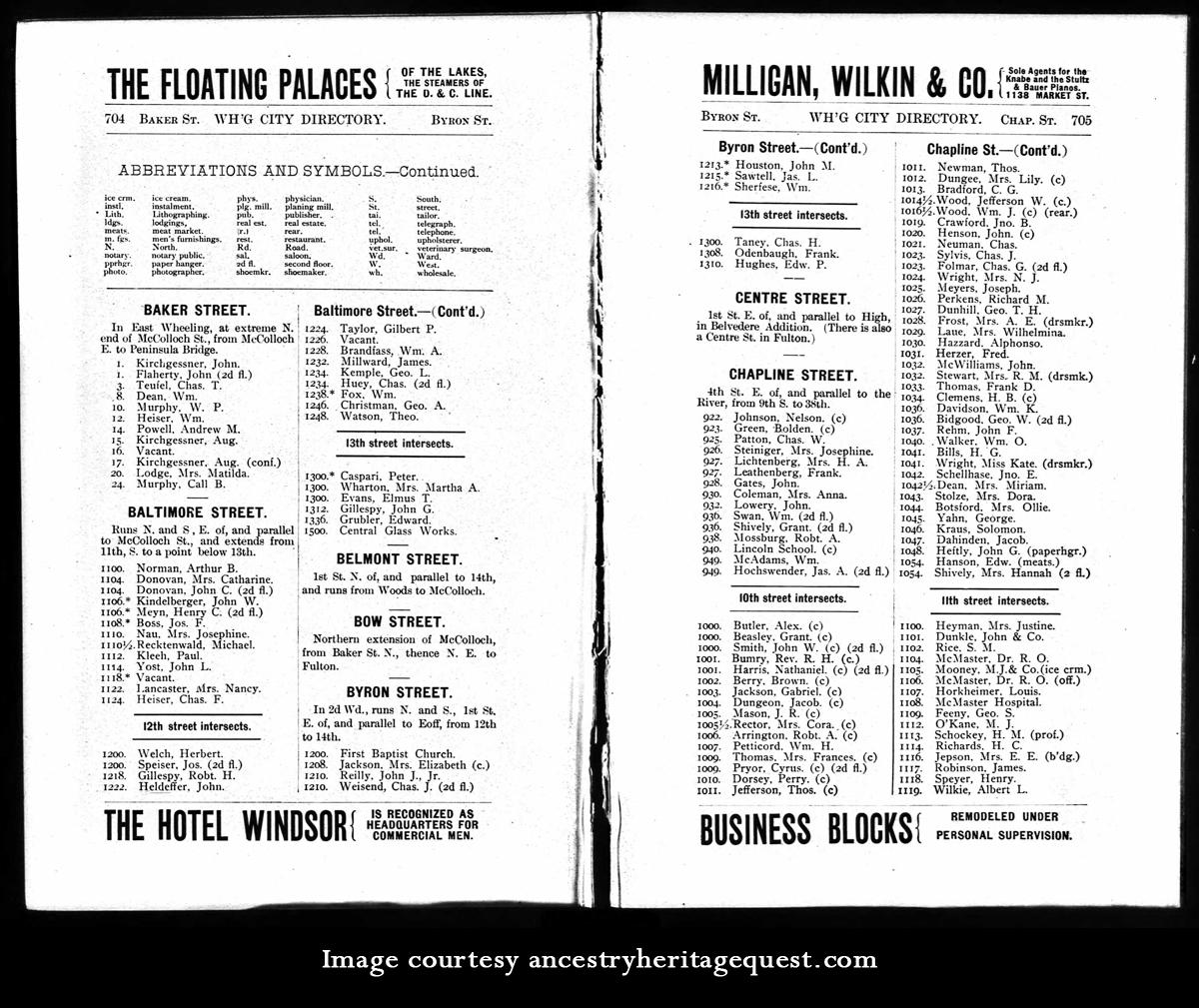 City Directories are a great way to find out who lived in your building or what businesses occupied your building. One thing that is important to note is that city directories only tell you occupants of a building, not necessarily owners. This means tenants may be listed instead of the actual building owner. You will still have to search the deeds to establish ownership.
City Directories are a great way to find out who lived in your building or what businesses occupied your building. One thing that is important to note is that city directories only tell you occupants of a building, not necessarily owners. This means tenants may be listed instead of the actual building owner. You will still have to search the deeds to establish ownership.
City directories list residents and business in alphabetical order, offering information about street address, occupation, business type, etc. That's great if you know who or what occupied your building at a given time. But what if you don't have that information. Luckily, starting in 1898, most City Directories in Wheeling included a reserve street directory. In the reserve directory, street names are listed alphabetically, then occupants — both residential and business — are listed for each street address numerically.
NOTE: The names of the streets in Wheeling were changed on July 11, 1873. If you are doing research on your building prior to 1873, your house might have had a different street name. Even if your building's street name didn't change (Market and Main streets, for instance, stayed the same), the numerical addresses may have changed in 1873.
➤ Download a handout of pre- and post-1873 Wheeling street names
-
Wheeling City Directories
Find city directories at the Library: OCPL's local history room — the Wheeling Room — houses Wheeling City Directories dating back to 1839. The directories are non-circulating and patrons must ask at the Reference Desk to obtain access to the Wheeling Room. No bags or backpacks are allowed in the Wheeling Room, though lockers are available. Notebooks, laptops, tablets and other recording materials are permitted.
➤ View full Wheeling Room rules
OCPL Call #s: Wheeling 917.5415025 (View catalog listings)
➤ View a list years for which the Library has City Directories of WheelingOnline Access to Wheeling City Directories: OCPL cardholders have online access to many Wheeling City Directories through Ancestry's HeritageQuest. Patrons accessing HeritageQuest outside of the Library must first log in with their OCPL-issued Library card number.
NOTE: We have created an online spreadsheet with quick links to alphabetical listings as well as reserve street directories and business directories for each year available.
➤ View the spreadsheet of Wheeling City Directories Available Through HeritageQuest
Maps
Maps are a great way to pin down your building's historic location and boundaries, determine when outbuildings were located on the property and when, see over time if wings, annexes, or extensions were added or razed, determine the historic construction material composition of a building, prior ownership, and specific uses of the building. By viewing different types of maps from different eras, you will be able to begin to build a narrative over time on how your structure physically changed and more.
-
Maps in the Library's Archives: The Library's Archives has Wheeling maps and atlases showing building-level details dating back to 1853. OCPL's Archival Materials are available by appointment only. Appointments can be made by calling 304-232-0244 or emailing [email protected].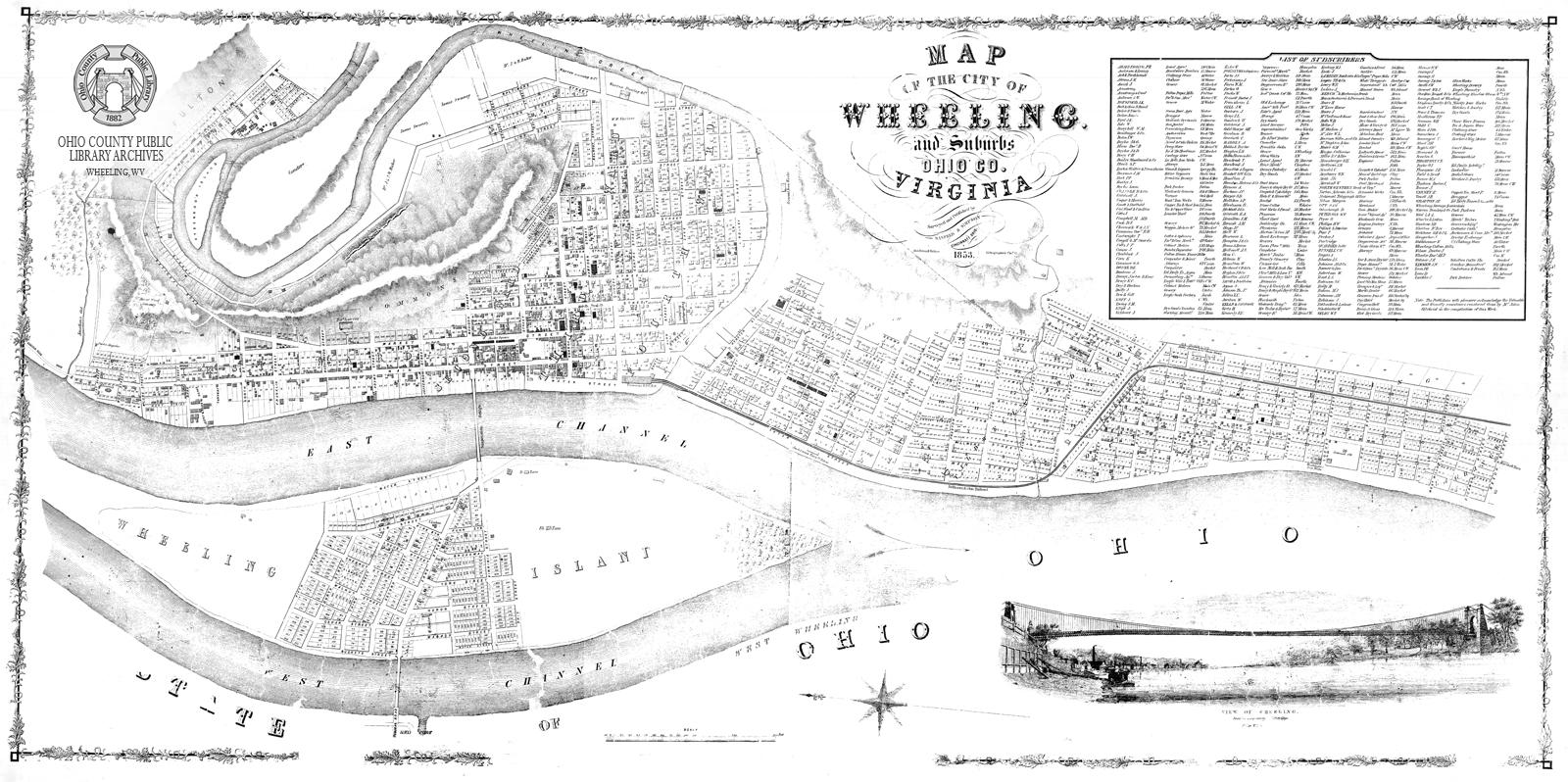 Wheeling Area Maps
Wheeling Area Maps
➤ View a full listing of all Wheeling Area Maps in the Library's Archives
Some of the maps in the Library's collections have been digitized and are available online.
The following digitized maps show building level details and in some cases list business and owner names:
➤ 1853: Map of the City of Wheeling and Suburbs, Ohio Co., Virginia
➤ 1871: Map of the City of Wheeling, South Wheeling and La Grange, West Virginia
➤ 1901: Atlas of the City of Wheeling (fifteen map plates of different wards plus index map)
➤ 1913: Map of Wheeling Showing Great Number of Privy Vaults
The 1918 Farmline map shows historic property owners and boundaries for Ohio County Properties outside of the Downtown Wheeling area.
➤ 1918: Map of Ohio County, West Virginia, 1918 (Farmline map) -
Sanborn Fire Insurance Maps
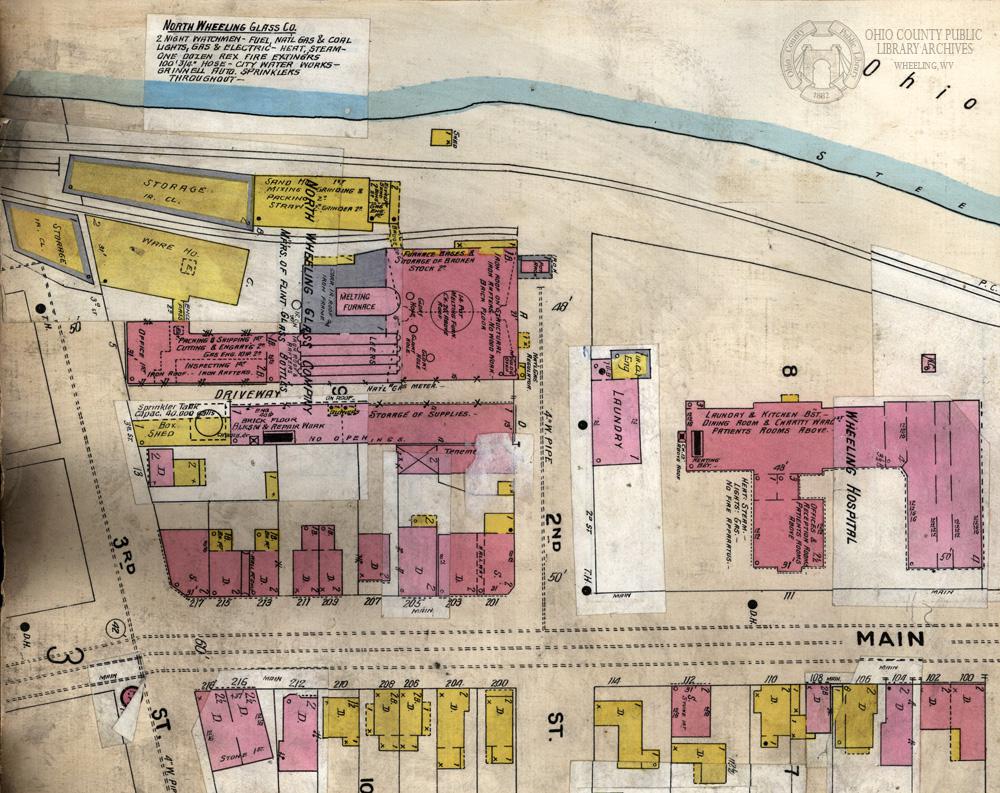 Sanborn Maps are particularly valuable when researching building histories. These maps — originally intended to aid fire insurance companies — show a building's footprint, the construction material, the building's height or number of stories, the building's use, property lot lines, road widths, and water and gas lines. A lot of information about your building can be gleaned from these maps. The maps use a combination of colors and symbols to pack some much information into a fairly small space.
Sanborn Maps are particularly valuable when researching building histories. These maps — originally intended to aid fire insurance companies — show a building's footprint, the construction material, the building's height or number of stories, the building's use, property lot lines, road widths, and water and gas lines. A lot of information about your building can be gleaned from these maps. The maps use a combination of colors and symbols to pack some much information into a fairly small space.
➤ View the Library of Congress' Resource Guide for Interpreting Sanborn Maps
Sanborn maps were printed periodically, so using these maps can also help you establish approximate construction dates, when additions were erected, when outbuildings were added or removed, and when building materials changed.
Sanborn Maps in the Library's Archives: The Library's Archives has Wheeling area Sanborn maps for the years 1902, 1921-1922, and 1952. These maps are available to view by appointment only. Appointments can be made by calling 304-232-0244 or emailing [email protected].
Sanborn Maps Online: Fortunately, Wheeling area Sanborn maps have been digitized and made available online by the Library of Congress. The following years are available through the loc.gov website.
➤ 1884
➤ 1890
➤ 1902
➤ 1921-1922: Vol. 1 | Vol. 2
➤ 1921-1951: Vol. 1 | Vol. 2
➤ 1952: Vol. 1 | Vol. 2
Publications
Publications provide one of the best ways to learn the story of your house and its inhabitants, or your building and the business that occupied it. The digitization of publications such as newspapers and trade journals make finding this information much easier through online accessibility and keyword searches. Some research that used to depend on visiting library archives and viewing reels and reels of microfilm can now be done online. Searching for property owner's name, a street address, or a business name can lead to finding significant details about your building.
Newpapers
Residential: Searching the local newspapers, you might find an interesting event for your house and the visitors who stopped by reported in the social columns. You can see if your street was located along parade routes. You might even find announcements about the property being constructed or sold.
Businesses: Dates when businesses moved into, vacated, constructed, or added onto, or razed buildings were often reported in the newspapers. Significant events such as fires, visits by dignitaries, political rallies, etc. can also often be connected to your building through newspaper reports.
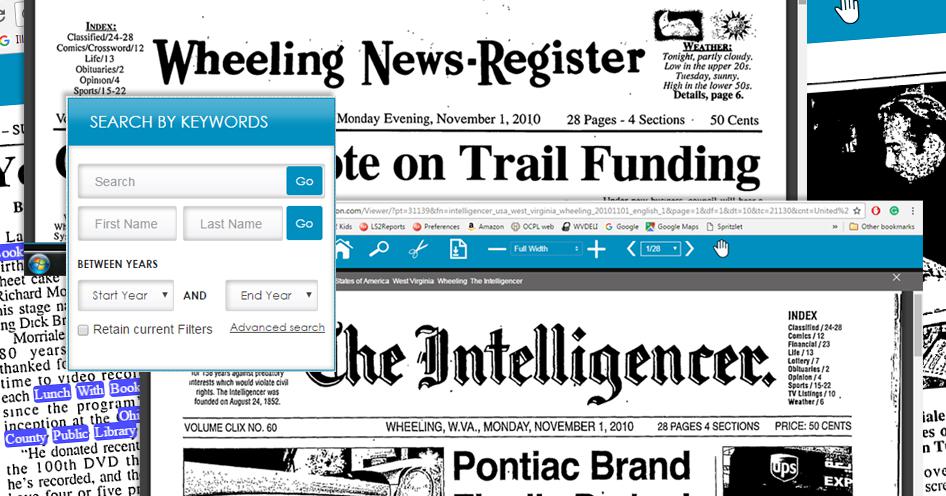 OCPL's Digitized Wheeling Newspapers
OCPL's Digitized Wheeling Newspapers
The Library has now digitized the entire run of the Intelligencer newspapers from 1852-present online. The News-Register from 1863-1920 is now online with many of the Sunday editions available to the present. More dates will be added to our collection as we continue to process our microfilm.
➤ Start searching the Library's digitized newspapers
➤ View a tutorial on creating article clippings from our digital newspapers.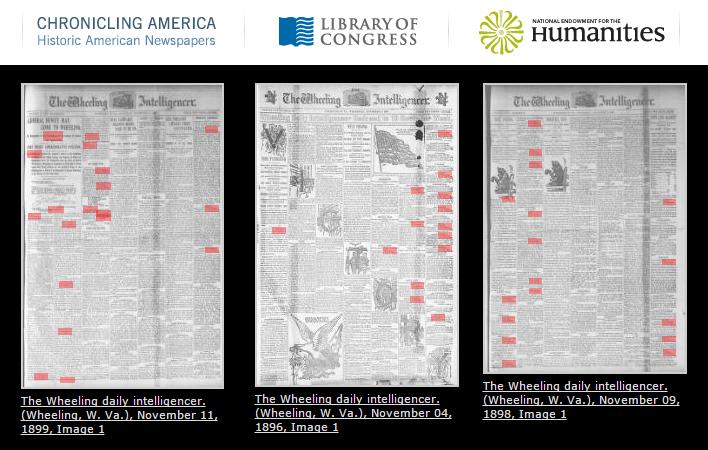 The Library of Congress Newspaper Archive: Chronicling America
The Library of Congress Newspaper Archive: Chronicling America
Sponsored jointly by the National Endowment for the Humanities and the Library of Congress, Chronicling America allows you to search historic American newspapers from 1789-1924.
Local newspapers available through Chronicling America:
The Wheeling Daily Intelligencer is available through Chronicling America from 1852-1922, the Wheeling Daily Register from 1863-1897, the Wheeling Repository (weekly) from March 1807 to May 8, 1808, the Virginia Statesman, (weekly) from January 1928 to June 1929, the Wheeling Compiler (weekly) from July 1829 to December 1830 (some issues missing), and the Wheeling Times and Advertiser from 1840-1848.
To find Wheeling papers, click the "Advanced Search" tab and either select by state or by newspaper.
➤ Start searching newspapers Chronicling America
Trade Publications
Google Books and HaithiTrust digitized many trade journals including architectural publications, contractor publications (cement, steel, etc), business publications (shoe retailers, hotel journals, etc.) that have invaluable information about buildings, their creators and constructors, and the businesses that occupied them. Doing targeted keyword searches for Wheeling businesses, owner names, physical addresses, and architects can sometime yield amazing information about a property.
- Google Books
Google has scanned thousands of books, magazines, and journals. Those that are in the public domain are fully available online. Information can still be searched for and accessed from publications that are not yet in the public domain and preview snippets often give you useful information. Many articles from publications that are not in the public domain may be obtained through interlibrary loan if requested.
➤ Start searching Google Books
TIP: When searching, put separate search terms in quotations. Using quotations forces a search engine to search for an exact word. Example: When searching for historic information about the old Library Building on Market Street, entering [Wheeling Library Architect] is too broad. We'll get results for publications that include the words Wheeling, Library, and Architect as well as the words Architects, Architecture, Libraries, Librarians, Built, etc.
But if we enter [ "Wheeling" "Library" "Architect" ] into a Google Books search, pulling up the third publication listing will give us the architect name Charles W. Bates. We can now refine [ "Wheeling" "Library" "Charles W. Bates" ] to get even more targeted results. - HathiTrust Digital Library
HathiTrust is a partnership of academic and research institutions who have digitized a collection of millions of titles from libraries around the world. Much like Google Books, titles that are in the public domain are fully available online through HathiTrust. Publications that are not yet in the public domain are not accessible publicly, but information about the journal or title will be given and may be able to be obtained through interlibrary loan if requested.
➤ Start searching HathiTrust Digital Library
Describing Your Building's Character
What Architectural Style Is My Building?
Architectural styles, though sometimes straight-forward, are not always easy to determine. Some buildings may have lacked any obvious defining characteristics from the start while others may have lost many defining details due to renovations, additions, and "modernizations." To determine your building's architectural significant style, you will need to take into consideration the age of the building along with the visual and structural cues provided by the building's features such as windows, doors, rooflines, etc., and materials.
- A Field Guide to American
 Houses: The Definitive Guide to Identifying and Understanding America's Domestic Architecture
Houses: The Definitive Guide to Identifying and Understanding America's Domestic Architecture
Not sure if your building falls under the style of Federal, Georgian, Romanesque, Craftsman, Second Empire, etc.? This is an excellent guide to the different eras of American architecture. It not only breaks down the different architectural styles by time period — from Colonial to Modern eras — but also breaks down predominant styles by region with maps. Illustrations highlight features typical of each style and multiple photographs of different types of buildings from each era are included to help you identify your building's architectural style.Find this book at the Library: This book is in our circulating collection. OCPL library cardholders may check the book out for two weeks at a time.
OCPL Call #: 728.0973 McAl 2015 (View catalog listing)[Citation: McAlester, V., & McAlester, A. L. (2015). A field guide to American houses: The definitive guide to identifying and understanding America's domestic architecture. Alfred A. Knopf.]
How Do I Describe The Architectural Elements Of My Building?
Describing the architectural elements that make your building special and unique add to both the historic significance of the building and the integrity (if original to the building or the time period of significance). However, if you are not familiar with architectural terms, sometimes these distinctive characteristics can be hard to describe. The following resources can get you started putting names to elements.
-
 The Elements of Style: A Practical Encyclopedia of Interior Architectural Details from 1485 to the Present
The Elements of Style: A Practical Encyclopedia of Interior Architectural Details from 1485 to the Present
Arranged in sections by architectural eras, each era is broken down into color-coded tabbed sections by features — orange for doors, yellow for windows, green for walls, etc. If you know your building's architectural style, this very visual guide filled with illustrations and photographs can help you properly describe the features that give your building architectural significance and integrity.
Find this book at the Library: This book is in our circulating collection. OCPL library cardholders may check the book out for two weeks at a time.
OCPL Call #: 721 EL26 1991 (View catalog listing)[Citation: Calloway, S., & Cromley, E. C. (1991). The Elements of style : a practical encyclopedia of interior architectural details, from 1485 to the present. Simon and Schuster.]
- Illustrated Dictionary of Historic Architectur
 e
e
Are the columns on your portico Corinthian or Doric or are they a composite? Are they actually columns, or are they pilasters? Is your masonry laid in an English bond or a Flemish bond? Do you have a gabled roof of a hipped roof? Does your mantle feature an ornamental festoon or swag? What's the difference between a frieze, a fascia, and a dado? With terms listed alphabetically, this book is an excellent reference, filled with visual illustrations and simple definitions to answer your architectural questions and guide you through the process of describing your building's unique details.
Find this book at the Library: OCPL has a copy of this book in their reference section. It is a non-circulating copy, meaning it is only available for use in the Library and cannot be checked out to take home. The Library, however, can obtain a circulating copy of the book through interlibrary loan if requested.
OCPL Call #: R 720.3 IL6 (View catalog listing)
Digital Copy: An ebook of Illustrated Dictionary of Historic Architecture is available for OCPL library cardholders through WVDeli and Hoopla Digital.
[Citation: Harris, C. M. (1983). Illustrated dictionary of historic architecture. Dover.]
What Resources Are Available To Help Me Restore My Building?
- City of Wheeling Façade Improvement Program
The City of Wheeling’s Façade Improvement Program (FIP) is program designed to assist building owners and tenants to make improvements to their façades to support the revitalization of the City of Wheeling by
stimulating private investment in high-quality improvements that enhance the appearance of buildings
and properties and eliminate blight and non-conforming design standards. Eligible properties can receive reimbursement up to $15,000 per property for façade improvements.
Eligible properties include:
1) Privately owned commercial buildings within the C-1 and C-2 zoning districts and the Central Business District (view map).
2) Any property (residential or commercial) in a qualified historic district in the City of Wheeling that has approved Design Review guidelines that remain enforceable and otherwise in effect (view map).
Learn more:
➤ Review Façade Improvement Program Guidelines
➤ View Downtown Wheeling Historic District Preservation Design Review Guidelines
➤ View Centre Market Square Historic District Preservation Design Review Guidelines
➤ View Chapline Street Row Historic District Preservation Design Review Guidelines
➤ View North Wheeling Historic District Preservation Design Review Guidelines
➤ Download a Façade Improvement Program Application
To learn more, contact:
Nancy Prager, Façade Improvement Program Director, City of Wheeling
Email: [email protected]
Phone: 304-234-3701
NOTE: If you have questions about the design guidelines or their interpretation, Wheeling Heritage offers assistance. Downtown and Centre Market business owners can schedule an appointment with Wheeling Heritage to receive free design assistance, including facade improvement recommendations and renderings. - Friends of Wheeling Loan Guarantee Program
This program provides funds for collateral on bank loans of up to $25,000, allowing borrowers to get prime
interest rates. Loans can be used for interior or exterior work on residential or commercial structures that are
of historic value.
To learn more, contact:
Jeanne Finstein, President of Friends of Wheeling
Email: [email protected]
Phone: 304-242-0341 - Design Assistance through Wheeling Heritage
Wheeling Heritage, through Main Street West Virginia, provides design assistance to historic property owners
located in the Wheeling Main Street District. Services include building improvement recommendations, tax
credit advice, façade renderings, and general guidance. Services are provided at no cost on a first-come, first-serve basis.
The scope of the services includes requests for recommendations on new signage, awnings, window replacements, painting, cleaning, storefront renovations, interpreting standards and codes, and complete building rehabilitation for property owners within the district.
To learn more, contact:
Betsy Sweeny, Director of Heritage Programming, Wheeling Heritage
Email: [email protected]
Phone: 304.232.3087 - State Grants through the West Virginia State Historic Preservation Office (SHPO)
The state provides two historic preservation grant programs: Survey and Planning, and Development Grants.
Development grants provide assistance to organizations and individuals for the protection, rehabilitation,
restoration, and stabilization of resources listed in the National Register. Annual deadlines for the Development Grant Application: Applications must be postmarked by March 31 (or April 1 if March 31 falls on Sunday).
Survey and Planning grants provide funds for planning activities such as individual or district nomination, preservation feasibility studies, and other preparatory activities. The annual deadline for Survey and Planning Grant Applications (CLG Grant Program) is October 31.
➤ View guidelines and download applications forms for both grants
To learn more, contact:
Christina Moore, Grants Coordinator, WV State Historic Preservation Office, West Virginia Department of Arts, Culture & History, Charleston, WV
Email: [email protected]
Phone: 304-558-0240 ext. 720
NOTE: Assistance with grant proposals for is offered by Wheeling Heritage. - Historic Rehabilitation Tax Credits at the Federal & State level
The Rehabilitation Investment Tax Credit Program provides for a federal income tax credit and a West Virginia state income tax credit for the rehabilitation of historic, income producing properties on or eligible for the National Register of Historic Places. This includes buildings that are individually listed on the National Register as well as properties listed as a contributing building within a historic district (Click here for information Ohio County Historic Districts and National Register properties).
Federal: Under the provisions of the Tax Reform Act of 1986, a 20% federal tax credit (4% taken over 5 years for a total of 20%) is available for the substantial rehabilitation of buildings that are certified as historic. The credit is applied directly against taxes owed by the owner.
State: There is a similar 25% state income tax credit available to owners. For non-income producing properties, the state provides a 20% residential credit to offset costs associated with rehabilitating a private, certified historic residence.
The State Historic Preservation Office (SHPO) administers both the federal and state tax credit programs in West Virginia. In some cases, taxpayers can qualify under both.
➤ View guidelines and download applications forms for both Commercial/Income-Producing Properties and Homeowner/Residential Properties
➤ Download West Virginia Living's Historic Tax Credit Toolkit booklet
To learn more, contact:
Tax Credit Coordinator, West Virginia State Historic Preservation Office, The Cultural Center, 1900 Kanawha Boulevard East, Charleston, WV
Phone: 304-558-0240 ext 138
Is my building already listed in on the National Register or a contributing building within a Wheeling historic district?
National Register Historic Districts in Ohio County:
➤ View the Historic Districts in Ohio County, view maps of the districts, and download nomination forms where contributing buildings are listed
Individual National Register Properties in Ohio County:
➤ View a list of individual Ohio County properties listed on the National Register of Historic Places and download their nomination forms
Resources for Building Preservation
Hands-on Learning Experience
 Belmont Technical College Building Preservation & Restoration Program
Belmont Technical College Building Preservation & Restoration Program
Wheeling has the unique distinction of being located 15 miles away from one of the oldest and most recognized Building Preservation and Restoration (BPR) programs in the nation. Located across the Ohio River in St. Clairsville, Ohio, Belmont College's BPR program's emphasis on “hands-on” learning has established its curriculum as a national model for traditional trade’s education. Though it offers a two-year Associate's of Applied Science degree for full-time students, homeowners and enthusiasts can take individual courses.
Belmont College's BPR Program offers classes in:
➤ Decorative Finishes (Paint, Stains, Wallpaper, Faux Marble & Graining, Gilding)
➤ Masonry and Ceramics (Brickwork, Stonework, Tiles)
➤ Mechanical Systems (Heating, Plumbing, Electrical)
➤ Metals (Blacksmithing, Welding)
➤ Plaster and Composition (Flat-wall and ornamental plaster)
➤ Roofing and Flooring
➤ Stained Glass
➤ Windows and Doors
➤ Wood
For more information, contact:
David Mertz, Professor and Program Chair, Building Preservation & Restoration Program, Belmont Technical College, St. Clairsville, OH
Email: [email protected]
Phone: 740-699-3939
Self-Guided Reference
 Restoring Your Historic House: The Comprehensive Guide for Homeowners
Restoring Your Historic House: The Comprehensive Guide for Homeowners
This comprehensive book walks readers through all aspects of restoring an old building from finding the right house, to working with code-enforcement offices and local and state historic preservation offices, to do-it-yourself repairs and remodels for interiors, exteriors, and mechanical systems. Filled with practical and technical information, cases studies and, illustrated step-by-step how-to instructions, each section is also accompanied by a featured home where readers can view real-life applications of the how the preservation techniques are practiced.
Find this book at the Library: This book is in our circulating collection. OCPL library cardholders may check the book out for two weeks at a time.
OCPL Call #: 720.286 Hans 2019 (View catalog listing)[Citation: Hanson, S. T., & Clough, D. J. (2019). Restoring your historic house: The comprehensive guide for homeowners. Tilbury House Publishers.]
 Building Evaluation for Adaptive Reuse and Preservation
Building Evaluation for Adaptive Reuse and Preservation
For investors and business owners, purchasing and remodeling a historic property can be an excellent investment. Historic preservation conserves resources, reduces waste and carbon footprints, and can be affordable for businesses to rehabilitate because of the possibility of tax incentives and grants. It also preserves the charm and unique aspects of a neighborhoods or community, attracting tourism and new residents. This practical guide walks you through the process of evaluating an existing building's structure, systems, and materials necessary for both design considerations and financial feasibility for midsize commercial, small commercial, and residential buildings. The book details each step to evaluating structural and material integrity in an assessment process in an easy-to-understand way covering everything from foundation issues to decorative details, identifying the causes of building failures as well as techniques for repair.
Find this book at the Library: This book is in our circulating collection. However, it is housed in our Closed Stacks shelves, meaning it is not readily accessible to the public and must be requested to view or check out. Though this book is in Closed Stacks, OCPL library cardholders may still check the book out for two weeks at a time. Ask for this book at the Reference Desk.
OCPL Call #: CS 721.028 R114b 2009 (View catalog listing)
[Citation: Rabun, J. S., & Kelso, R. M. (2009). Building evaluation for adaptive reuse and preservation. John Wiley & sons.]
➤ For further assistance researching your historic property, contact us through our Ask a Local History Specialist form.
➤ To request an appointment to view archival materials or see what archival materials might be available to assist you in your search, contact us through our Ask an Archivist form.








